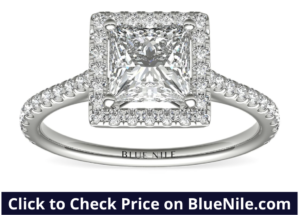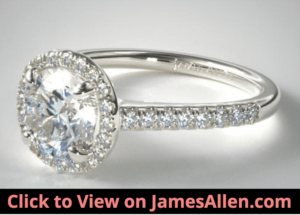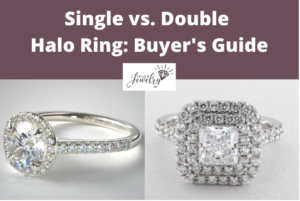
There are multiple options to choose from within halo settings, namely a single or double.
The main difference between a single and double halo is a single halo features only one ring of accents around the diamond. Double halos add another layer to increase the total carat weight of the piece. Both can cause the center diamond to appear larger.
I’ll compare single versus double halo rings in areas such as price, brilliance, size, and more, so you’ll know which is right for you.
What is a Single Halo Setting?
Single halo engagement ring settings include a center diamond with one circle of diamonds or gemstones surrounding it.
As an example, check out this halo setting in 14K yellow gold.
When you rotate the image to directly face you, notice how the round-cuts form an outline to mimic the pear-cut diamond in the middle.
This illustrates how the halo often forms the shape of the diamond.
The smaller stones are placed tightly together, wrapping the center stone and often making it appear as one larger stone when they’re the same cut.
There are variations of the single halo setting where the surrounding stones form a square, diamond, or octagon around the center one.
Here’s one surrounding a princess cut.
Because princess cuts have a square outline, it makes sense for the single halo to align with it.
The versatile setting adds brilliance and a layer of protection not present in a solitaire setting.
What is a Double Halo?
A double halo engagement ring setting differs from a single halo in that it has two layers of diamonds surrounding the center stone.
In some styles of halos, the second level mimics the first, with accents of a similar size, color, and placement. In other cases, it contrasts the inner circle to create a more layered aesthetic.
The example below matches the former description.
Both layers are identical, and all are round cut diamonds.
But similar to a single halo, the surrounding accents can form multiple shapes.
It can create a square around a round diamond, or the gems are around a pear-shaped diamond.
The double halo, combined with a sparkling center stone and pave diamonds down the shank, can maximize the piece’s brilliance.
What are the Differences Between the Settings?
Price
All else being equal, a double halo ring is more expensive than a single halo because it features more diamonds.
Similar to above, this ring has a double halo plus pavé.
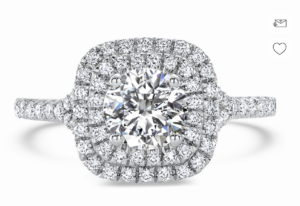
If you have the same center diamond, shank, and surrounding gems, the difference in cost amounts to the price of the second layer of gems.
Compared to a solitaire setting with just one diamond, a double halo is cheaper, as long as the total carat weight (CTTW) is the same.
There’s a simple explanation.
A single large diamond is more expensive than several small diamonds, even if they add up to the same weight.
The price of a single halo setting at a quality jewelry retailer starts around $500 and can stretch up to $8,000.
The differences are a result of the type of shank, such as whether it’s made of 14K yellow gold, 18K white gold, or platinum and the CTTW of the diamonds forming the halo and running down the shank.
For example, the price of this single halo setting changes depending on the metal:
- 14K white gold: $1,410
- 18K white gold: $1,640
- Platinum: $1,780
Double halo rings follow the same pattern but generally start at a higher price than single halos.
To illustrate, the double halo setting on the left has ⅜ CTTW and costs $1,490.
The setting on the right has 7/8 CTTW and costs $5,200.
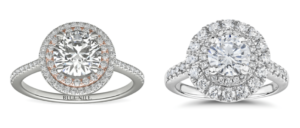
Brilliance
Double halo engagement ring settings are often more brilliant than single halos.
Adding another ring of halos is an effective way to increase the brilliance of a ring without breaking the bank.
If you compare a solitaire setting, a single halo, and a double halo that had the same CTTW, it’s likely the double halo would be the least expensive because the CTTW is divided between more diamonds.
Even if they all have a similarly sized surface area, the double halo would cost far less.
Size
As a general rule, single halos make your ring look half a carat bigger, and a double halo adds an extra half carat on top of that. So your ring can look a full carat larger with two halos.
If you were to go from a one carat center diamond to a 1.5 carat diamond, it could cost $5,000-$8,000 more, if all other qualities about the diamond are the same.
If you were to add a full carat and purchase a two-carat diamond, it could cost $15,000-$18,000 more.
The image below shows the price of a 1.5-carat diamond at $10,290, and a two-carat diamond at $21,510.
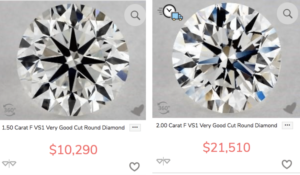
By instead adding a single or double halo of gems around a one carat diamond, it might only cost between $500 and $2,000.
Repairs and Cleaning
Repairs are an issue for both single and double halos, but you’ll have more trouble repairing a double halo because it features a higher number of small diamonds.
When the diamonds are tightly placed around the center diamond, it means there’s little room for error if some fall out.
If they need to be replaced, you’ll have to find ones of the exact size. It can be difficult to know the specifications of those accents because they’re often not evaluated in the same ways as larger diamonds.
Double halos are also difficult to clean because there are more areas for dirt and grime to accumulate.
Have single and double halo settings professionally cleaned and maintained twice per year.
Cleaning them yourself, or placing them in an ultrasonic cleaner, may shake those small stones loose.
Is a Single or Double Halo Right For You?
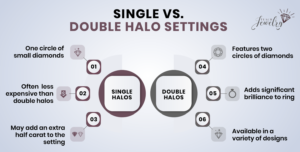
The choice between a single halo versus double halo ring involves comparing the two settings across multiple categories.
If you want the appearance of a much larger diamond, select a double halo where all the diamonds are the same color and cut.
From a distance, they’ll blend and exhibit strong brilliance.
It’ll generally cost more than a single halo because of a higher CTTW, but it offers savings compared to a solitaire of the same weight.
Consider a single halo if you want the sparkle of a larger diamond but your budget is limited.
By spreading the CTTW across the piece, you’ll save money and give your diamond added protection.
By comparing single and double halo settings in areas such as price, brilliance, and ease of repairs and cleaning, you’ll find the piece that’s right for you.

Jacob Clarke
Jacob Clarke is the founder of TeachJewelry.com.
He earned an Applied Jewelry Professional Diploma from the Gemological Institute of America (GIA) and now brings you essential information about diamonds, settings, and more.
Jacob has consulted with leading jewelry brands, and his work has been cited in Clean Origin, Diamond Nexus and industry publications.
He's also a member of the International Gem Society.
He enjoys discussing jewelry with readers, so contact him with any questions at jacob.clarke@teachjewelry.com.

